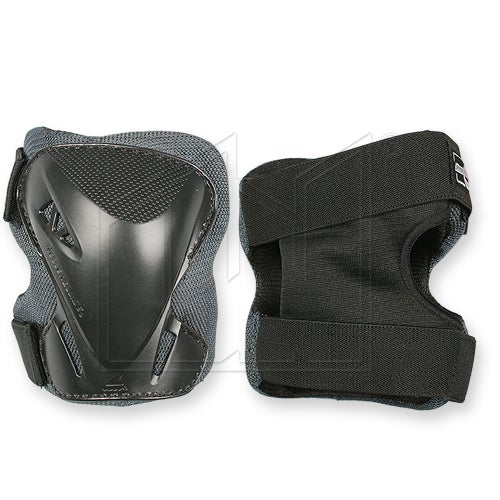My experience in skating was that I hit my elbows, knees and hips more than I ever hit my wrists and head. Fortunately, your hips, knees and elbows are pretty tough and seldom suffer injury. But, there's no reason you need to skate in pain or risk an injury while you're learning. Why not wear pads?
Well, most people don't wear pads because they look unattractive. But even the cheap stuff you buy at a big box store usually works for beginners. It's only when you get past the first few basic skills that you realize that these cheap pads can interfere with your skating mobility and body position. Let's look at knee pads today, since when you first learn to skate you'll spend time on your knees.
Knee Pads
There's three main kinds: volleyball pads, inline skating pads, and figure skating pads. I'll go over the pros and cons for each.
 |
| Volleyball Kneepads |
Volleyball knee pads come in a variety of styles and quality. You can spot them because the pad is integrated into the leg sleeve. Some have foam pads (cheaper), others have gel (more expensive, but better). Depending on what you wear, you can probably get some styles of pads under a pair of slacks. If you go with these make sure they have an opening in the back of the sleeve to allow for knee bend.
Pros: They work and aren't too confining. I knew a man at Freestyle 4 level who jumped (and fell) in these without problems. I've seen higher level skaters wearing a single pad in practice (I assume to protect an injured knee). Cheap to moderately expensive. Widely available.
Cons: Can't wear them for testing or competition. Some people may feel they interfere with certain elements. If you have large legs, the sleeve may be too restrictive.
 |
Inline skating kneepad
Hard shell
|
Inline skating knee pads come in a bewildering variety of designs and levels of quality. Hard shell (as in the picture to the left). Softcap (similar to the volleyball knee pad). Pad integrated into the sleeve, or pad held in place with straps. What distinguishes Inline Skating pads from volleyball pads is that inline pads are generally thicker and designed for someone falling onto concrete.
I have seen these types of pads on many small children in Learn to Skate and a very few adults in Pre-Alpha (Basic 1) type classes. Generally adults give up on these as they are too thick to wear under clothes and must be worn over clothes. Once an adult gets steady on the ice, they seem to go to other protection solutions.
Pros: They work really well. Cheap. Available everywhere.
Cons: Hard to get on. Hard to get to stay in place. Most are designed to be worn over bare legs, not slacks. Bulky and may interfere with moves like cross overs.
 |
| Skating Safe Pad |
As far as I know, there is one figure skating knee pad. Designed by a company called
SkatingSafe, they are a gel product. The picture to the left shows a pad in place on a knee. When you buy the pad, you just get the pad. You have to figure out how to keep it in place. The company sells a retention sleeve, but I don't know of any adults who use them. If you are a woman you can hold the pad in place with your tights. I use capri length compression tights to hold mine in place. I suspect a man would use a similar solution. Carefully placed, these pads are invisible under clothing. I've heard of skaters wearing them under tights and they couldn't be seen.
For something so thin, they work like magic. I've taken some really hard falls in them and felt nothing. Zip. Nada. Zero. As I said, Magic.
Pros: Can be worn under clothes. Can be worn in testing and competition. Work well. Don't interfere with skating moves.
Cons: OMG. The Price. But my knees are worth it.
There's lots of options for different levels of ability. All of them work. There's lots of price differences so even someone on a budget could afford some kind of knee protection. As you advance you'll probably find yourself needing knee pads less and less as you gain stability. However, at some point you'll have a jump, or a piece of footwork than will land you on your knees and you'll take them up again. Ah, figure skating, the never ending cycle of pain.



















